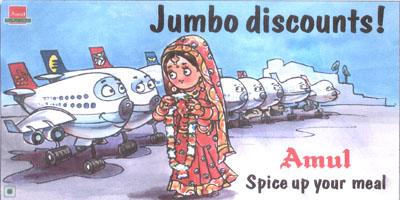 Every day Amul collects 447,000 litres of milk from 2.12 million farmers (many illiterate), converts the milk into branded, packaged products, and delivers goods worth Rs 6 crore (Rs 60 million) to over 500,000 retail outlets across the country.
Every day Amul collects 447,000 litres of milk from 2.12 million farmers (many illiterate), converts the milk into branded, packaged products, and delivers goods worth Rs 6 crore (Rs 60 million) to over 500,000 retail outlets across the country.
Its supply chain is easily one of the most complicated in the world. How do managers at Amul prevent the milk from souring?
Walk in to any Amul or Gujarat Cooperative Milk Marketing Federation (GCMMF) office, and you may or may not see a photograph of Mahatma Gandhi, but you will certainly see one particular photograph. It shows a long line of Gujarati women waiting patiently for a union truck to come and collect the milk they have brought in shining brass matkas.
The picture is always prominently displayed. The message is clear: never forget your primary customer. If you don't, success is certain. The proof? A unique, Rs 2,200 crore (Rs 22 billion) enterprise.
Organisation structure
It all started in December 1946 with a group of farmers keen to free themselves from intermediaries, gain access to markets and thereby ensure maximum returns for their efforts.
Based in the village of Anand, the Kaira District Milk Cooperative Union (better known as Amul) expanded exponentially. It joined hands with other milk cooperatives, and the Gujarat network now covers 2.12 million farmers, 10,411 village level milk collection centers and fourteen district level plants (unions) under the overall supervision of GCMMF.
There are similar federations in other states. Right from the beginning, there was recognition that this initiative would directly benefit and transform small farmers and contribute to the development of society.
Markets, then and even today, are primitive and poor in infrastructure. Amul and GCMMF acknowledged that development and growth could not be left to market forces and that proactive intervention was required. Two key requirements were identified.
The first, that sustained growth for the long term would depend on matching supply and demand. It would need heavy investment in the simultaneous development of suppliers and consumers.
Second, that effective management of the network and commercial viability would require professional managers and technocrats.
To implement their vision while retaining their focus on farmers, a hierarchical network of cooperatives was developed, which today forms the robust supply chain behind GCMMF's endeavors. The vast and complex supply chain stretches from small suppliers to large fragmented markets.
Management of this network is made more complex by the fact that GCMMF is directly responsible only for a small part of the chain, with a number of third party players (distributors, retailers and logistics support providers) playing large roles.
Managing this supply chain efficiently is critical as GCMMF's competitive position is driven by low consumer prices supported by a low cost system.
Developing demand
At the time Amul was formed, consumers had limited purchasing power, and modest consumption levels of milk and other dairy products. Thus Amul adopted a low-cost price strategy to make its products affordable and attractive to consumers by guaranteeing them value for money.
Introducing higher value products
Beginning with liquid milk, GCMMF enhanced the product mix through the progressive addition of higher value products while maintaining the desired growth in existing products.
Despite competition in the high value dairy product segments from firms such as Hindustan Lever, Nestle and Britannia, GCMMF ensures that the product mix and the sequence in which Amul introduces its products is consistent with the core philosophy of providing milk at a basic, affordable price.
The distribution network
Amul products are available in over 500,000 retail outlets across India through its network of over 3,500 distributors. There are 47 depots with dry and cold warehouses to buffer inventory of the entire range of products.
 GCMMF transacts on an advance demand draft basis from its wholesale dealers instead of the cheque system adopted by other major FMCG companies. This practice is consistent with GCMMF's philosophy of maintaining cash transactions throughout the supply chain and it also minimizes dumping.
GCMMF transacts on an advance demand draft basis from its wholesale dealers instead of the cheque system adopted by other major FMCG companies. This practice is consistent with GCMMF's philosophy of maintaining cash transactions throughout the supply chain and it also minimizes dumping.
Wholesale dealers carry inventory that is just adequate to take care of the transit time from the branch warehouse to their premises. This just-in-time inventory strategy improves dealers' return on investment (ROI). All GCMMF branches engage in route scheduling and have dedicated vehicle operations.
Umbrella brand
The network follows an umbrella branding strategy. Amul is the common brand for most product categories produced by various unions: liquid milk, milk powders, butter, ghee, cheese, cocoa products, sweets, ice-cream and condensed milk.
Amul's sub-brands include variants such as Amulspray, Amulspree, Amulya and Nutramul. The edible oil products are grouped around Dhara and Lokdhara, mineral water is sold under the Jal Dhara brand while fruit drinks bear the Safal name.
By insisting on an umbrella brand, GCMMF not only skillfully avoided inter-union conflicts but also created an opportunity for the union members to cooperate in developing products.
Managing the supply chain
Even though the cooperative was formed to bring together farmers, it was recognised that professional managers and technocrats would be required to manage the network effectively and make it commercially viable.
Coordination
Given the large number of organisations and entities in the supply chain and decentralised responsibility for various activities, effective coordination is critical for efficiency and cost control. GCMMF and the unions play a major role in this process and jointly achieve the desired degree of control.
Buy-in from the unions is assured as the plans are approved by GCMMF's board. The board is drawn from the heads of all the unions, and the boards of the unions comprise of farmers elected through village societies, thereby creating a situation of interlocking control.
The federation handles the distribution of end products and coordination with retailers and the dealers. The unions coordinate the supply side activities.
These include monitoring milk collection contractors, the supply of animal feed and other supplies, provision of veterinary services, and educational activities.
Managing third party service providers
From the beginning, it was recognised that the unions' core activity lay in milk processing and the production of dairy products. Accordingly, marketing efforts (including brand development) were assumed by GCMMF. All other activities were entrusted to third parties. These include logistics of milk collection, distribution of dairy products, sale of products through dealers and retail stores, provision of animal feed, and veterinary services.
It is worth noting that a number of these third parties are not in the organized sector, and many are not professionally managed with little regard for quality and service.
This is a particularly critical issue in the logistics and transport of a perishable commodity where there are already weaknesses in the basic infrastructure.
Establishing best practices
A key source of competitive advantage has been the enterprise's ability to continuously implement best practices across all elements of the network: the federation, the unions, the village societies and the distribution channel.
In developing these practices, the federation and the unions have adapted successful models from around the world. It could be the implementation of small group activities or quality circles at the federation. Or a TQM program at the unions. Or housekeeping and good accounting practices at the village society level.
More important, the network has been able to regularly roll out improvement programs across to a large number of members and the implementation rate is consistently high.
For example, every Friday, without fail, between 10.00 a.m. and 11.00 a.m., all employees of GCMMF meet at the closest office, be it a department or a branch or a depot to discuss their various quality concerns.
Each meeting has its pre-set format in terms of Purpose, Agenda and Limit (PAL) with a process check at the end to record how the meeting was conducted. Similar processes are in place at the village societies, the unions and even at the wholesaler and C&F agent levels as well.
Examples of benefits from recent initiatives include reduction in transportation time from the depots to the wholesale dealers, improvement in ROI of wholesale dealers, implementation of Zero Stock Out through improved availability of products at depots and also the implementation of Just-in-Time in finance to reduce the float.
Kaizens at the unions have helped improve the quality of milk in terms of acidity and sour milk. (Undertaken by multi-disciplined teams, Kaizens are highly focussed projects, reliant on a structured approach based on data gathering and analysis.) For example, Sabar Union's records show a reduction from 2.0% to 0.5% in the amount of sour milk/curd received at the union.
The most impressive aspect of this large-scale roll out is that improvement processes are turning the village societies into individual improvement centers.
Technology and e-initiatives
GCMMF's technology strategy is characterized by four distinct components: new products, process technology, and complementary assets to enhance milk production and e-commerce.
Few dairies of the world have the wide variety of products produced by the GCMMF network. Village societies are encouraged through subsidies to install chilling units. Automation in processing and packaging areas is common, as is HACCP certification. Amul actively pursues developments in embryo transfer and cattle breeding in order to improve cattle quality and increases in milk yields.
GCMMF was one of the first FMCG (fast-moving consumer goods) firms in India to employ Internet technologies to implement B2C commerce.
Today customers can order a variety of products through the Internet and be assured of timely delivery with cash payment upon receipt.
Another e-initiative underway is to provide farmers access to information relating to markets, technology and best practices in the dairy industry through net enabled kiosks in the villages.
GCMMF has also implemented a Geographical Information System (GIS) at both ends of the supply chain, i.e. milk collection as well as the marketing process.
Farmers now have better access to information on the output as well as support services while providing a better planning tool to marketing personnel.
The author is Professor at the Indian Institute of Management, Ahmedabad and Devnath Tripati, Editor of the Asian Journal of Operations Management.
Published with the kind permission of The Smart Manager, India's first world class management magazine, available bi-monthly.






 © 2025
© 2025